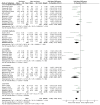Association between Serum Lactate and Morbidity and Mortality in Neonates: A Systematic Review and Meta-Analysis
- PMID: 38002887
- PMCID: PMC10670916
- DOI: 10.3390/children10111796
Association between Serum Lactate and Morbidity and Mortality in Neonates: A Systematic Review and Meta-Analysis
Abstract
Objective: Lactate is a marker of hypoperfusion in critically ill patients. Whether lactate is useful for identifying and stratifying neonates with a higher risk of adverse outcomes remains unknown. This study aimed to investigate the association between lactate and morbidity and mortality in neonates.
Methods: A meta-analysis was performed to determine the association between blood lactate levels and outcomes in neonates. Ovid MEDLINE, EMBASE, Cochrane Library, and ClinicalTrials.gov were searched from inception to 1 May 2021. A total of 49 observational studies and 14 data accuracy test studies were included. The risk of bias was assessed using the Newcastle-Ottawa Scale for observational studies and the QUADAS-2 tool for data accuracy test studies. The primary outcome was mortality, while the secondary outcomes included acute kidney injury, necessity for renal replacement therapy, neurological outcomes, respiratory morbidities, hemodynamic instability, and retinopathy of prematurity.
Results: Of the 3184 articles screened, 63 studies fulfilled all eligibility criteria, comprising 46,069 neonates. Higher lactate levels are associated with mortality (standard mean difference, -1.09 [95% CI, -1.46 to -0.73]). Using the estimated sensitivity (0.769) and specificity (0.791) and assuming a prevalence of 15% for adverse outcomes (median of prevalence among studies) in a hypothetical cohort of 10,000 neonates, assessing the lactate level alone would miss 346 (3.46%) cases (false negative) and wrongly diagnose 1776 (17.76%) cases (false positive).
Conclusions: Higher lactate levels are associated with a greater risk of mortality and morbidities in neonates. However, our results do not support the use of lactate as a screening test to identify adverse outcomes in newborns. Research efforts should focus on analyzing serial lactate measurements, rather than a single measurement.
Keywords: critical illness; lactate; mortality; neonates; newborn; preterm.
Conflict of interest statement
The authors declare no conflict of interest.
Figures





Similar articles
-
Risk Factors for Acute Kidney Injury in Critically Ill Neonates: A Systematic Review and Meta-Analysis.Front Pediatr. 2021 Jul 14;9:666507. doi: 10.3389/fped.2021.666507. eCollection 2021. Front Pediatr. 2021. PMID: 34336736 Free PMC article.
-
Lung recruitment manoeuvres for reducing mortality and respiratory morbidity in mechanically ventilated neonates.Cochrane Database Syst Rev. 2021 Mar 30;3(3):CD009969. doi: 10.1002/14651858.CD009969.pub2. Cochrane Database Syst Rev. 2021. PMID: 33781001 Free PMC article.
-
Nursing and midwifery management of hypoglycaemia in healthy term neonates.Int J Evid Based Healthc. 2005 Aug;3(7):169-205. doi: 10.1111/j.1479-6988.2005.00025.x. Int J Evid Based Healthc. 2005. PMID: 21631748
-
The future of Cochrane Neonatal.Early Hum Dev. 2020 Nov;150:105191. doi: 10.1016/j.earlhumdev.2020.105191. Epub 2020 Sep 12. Early Hum Dev. 2020. PMID: 33036834
-
Enteral zinc supplementation for prevention of morbidity and mortality in preterm neonates.Cochrane Database Syst Rev. 2021 Mar 12;3(3):CD012797. doi: 10.1002/14651858.CD012797.pub2. Cochrane Database Syst Rev. 2021. PMID: 33710626 Free PMC article.
Cited by
-
The association of umbilical hyperlactatemia with short- and tong-term outcomes in extremely low birth weight neonates: a matched cohort study.Eur J Pediatr. 2025 May 7;184(6):328. doi: 10.1007/s00431-025-06147-z. Eur J Pediatr. 2025. PMID: 40332591 Free PMC article.
-
Correlation of Arterial Lactate and pH With the Immediate Outcome of Term Asphyxiated Neonates.Cureus. 2025 Mar 5;17(3):e80093. doi: 10.7759/cureus.80093. eCollection 2025 Mar. Cureus. 2025. PMID: 40190879 Free PMC article.
-
Lactate, an Essential Metabolic Marker in the Diagnosis and Management of Pediatric Conditions.Diagnostics (Basel). 2025 Mar 23;15(7):816. doi: 10.3390/diagnostics15070816. Diagnostics (Basel). 2025. PMID: 40218166 Free PMC article. Review.
-
Urinary Lactate-To-Creatinine Ratio during the First Days of Life Correlates with the Degree of Brain Damage in Premature Infants.Neonatology. 2025;122(2):222-231. doi: 10.1159/000542793. Epub 2024 Dec 10. Neonatology. 2025. PMID: 39657616 Free PMC article.
References
Publication types
LinkOut - more resources
Full Text Sources

